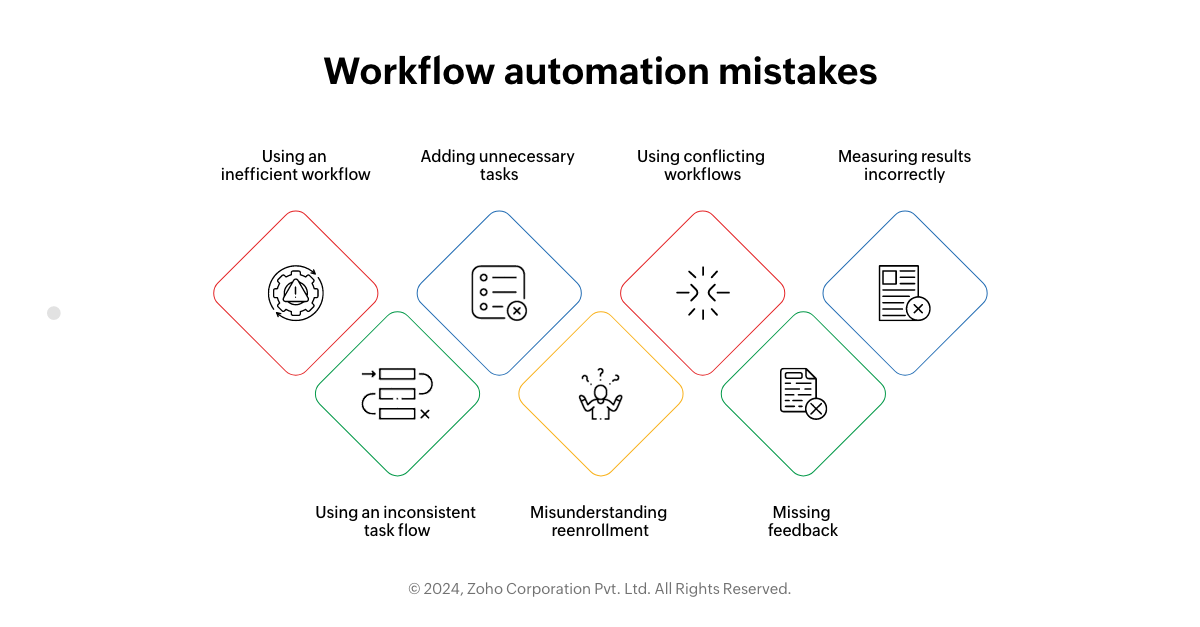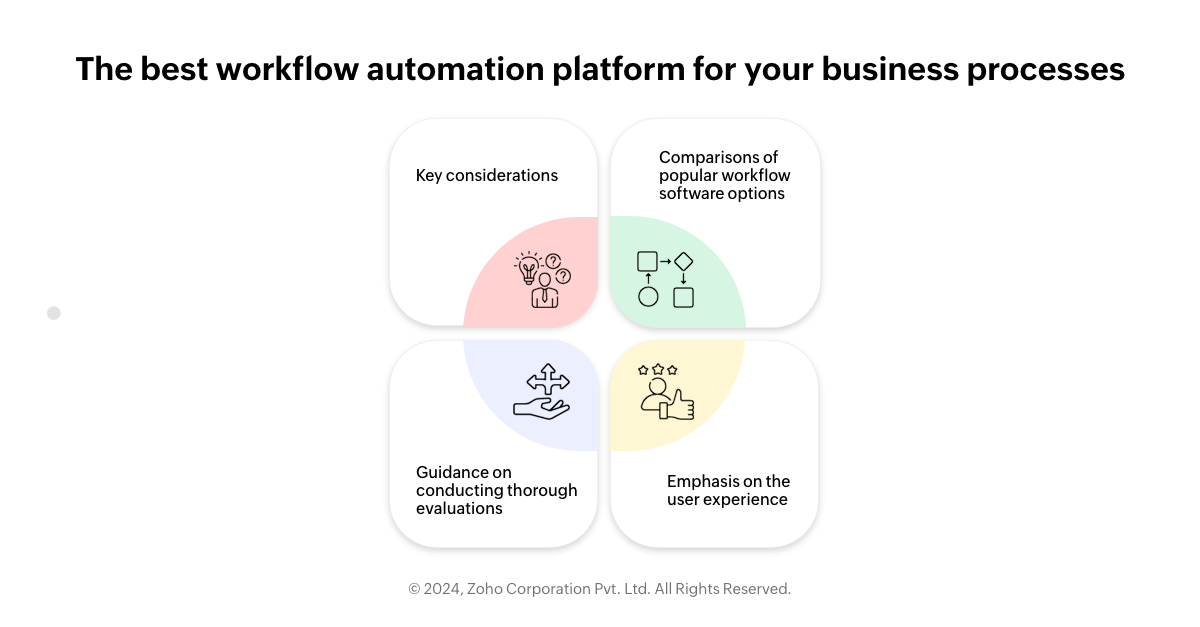- HOME
- Workflow automation
- How workflow automation tools can save you time and money
How workflow automation tools can save you time and money
- Last Updated: June 1, 2024
- 415 Views
- 12 Min Read

According to a Harvard Business Review survey, more than 90% of employees prefer automation tools over manual data entry. They feel that technology makes tedious processes easier, saving time and money.
Have you ever been intimidated by manual workflow management? What if there were a way to complete it quickly? With automation tools, workflow management becomes way easier and less time-consuming. In a previous blog, we discussed workflow management, and now, we will walk through how to automate your workflows, saving you both time and money.
A workflow refers to a series of tasks, actions, or steps that must be completed to accomplish a specific objective within business processes. Workflow automation software can make your business run more smoothly by automating repetitive tasks, boosting productivity with real-time insights, and increasing profits.
Common workflow mistakes and effective avoidance strategies
Mistake 1: Using an inefficient workflow
An inefficient workflow with too many steps and too much complexity can result in delays and manual data entry errors. This slows down your process and increases your costs.
Use technology to optimize your workflows
The strategic use of workflow automation software is the key to optimizing workflows. These tools help streamline processes by removing redundant steps, simplifying tasks, and enabling the automation of repetitive tasks action. Designing custom workflows that meet specific business processes becomes straightforward, enhancing overall efficiency and productivity.
Example
In a finance department, an inefficient workflow might involve manually entering expense reports into multiple systems, leading to delays and errors. If an employee submits an expense report via email, and it is manually entered into an accounting system by another staff member, then this process can be time-consuming and prone to mistakes.
With workflow automation, the same expense report can be automatically submitted through a digital form and immediately integrated into the accounting system without manual intervention. This eliminates delays, reduces errors, and speeds up the process significantly.
Mistake 2: Using an inconsistent task flow
An inconsistent task flow contains gaps, overlaps, and conflicts that lead to confusion, duplication, and contradiction. This ultimately reduces process quality and accuracy.
Keep your workflows consistent
Workflow automation tools are instrumental in creating consistent, logical task sequences. They ensure each task is systematically completed and transition smoothly to the next. These tools help maintain clear, organized workflows. The right tools also allow for the easy assignment of roles and responsibilities, ensuring manual tasks are managed by the appropriate teams, thus upholding workflow integrity.
Example
In a healthcare setting, an inconsistent task flow might occur when patient information is updated by a nurse but not promptly communicated to the doctor, causing delays in treatment and billing. When the nurse updates the patient's file, but the doctor is unaware because the information is manually passed on later, this leads to miscommunications and treatment delays.
With workflow automation, once a nurse updates patient information, it is immediately made accessible to the doctor for review and then forwarded to the billing department, ensuring continuity and accuracy in patient management. This ensures a smooth, logical progression of tasks, reducing delays and improving patient care.
Mistake 3: Adding unnecessary tasks
An unnecessary task does not add any value to your processes and outcomes. It results in waste, inefficiency, and distractions that hinder your process performance and effectiveness.
Make sure every task is necessary
Workflow automation software excels at identifying and removing redundant tasks that do not contribute value. This not only streamlines the process but also focuses your attention on tasks that genuinely add value, aligning closely with your strategic goals and ensuring more efficient workflow management.
Example
In a manufacturing plant, unnecessary tasks might involve manual machinery status updates that could be automated. If the operators manually check and report machinery statuses daily, this takes up valuable time that could be spent on maintenance and quality checks.
With workflow automation, machinery status updates can be automated and reported in real time, allowing operators to focus on more critical tasks. This improves efficiency and reduces wasted effort. The automated sensors can monitor and report machinery statuses, triggering maintenance tasks only when necessary and freeing up employees to focus on higher-value activities like quality control and process improvement.
Mistake 4: Misunderstanding reenrollment
Reenrollment enables objects such as contacts, leads, or deals to be enrolled in a workflow multiple times, triggered by specific criteria. Incorrect use of reenrollment features can lead to undesired outcomes through repeatedly enrolling objects into workflows unnecessarily.
Understand how reenrollment works
Reenrollment features in workflows, when used correctly, can significantly enhance follow-up efforts. Workflow automation tools offer capabilities for setting precise reenrollment criteria and triggers, which prevents misuse and ensures effective management.
Example
In a marketing department, workflow automation software can set specific criteria for reenrollment, ensuring that only the relevant items are reprocessed. The leads who haven't responded to an email campaign within a certain time frame can be automatically reenrolled into a follow-up sequence, preventing overcommunication with those who have already engaged with the campaign.
Mistake 5: Using conflicting workflows
Conflicting workflows refer to workflows that disrupt one another's processes, leading to undesirable effects on the same objects.
Avoid overlapping or contradicting workflows
Conflicting workflows create inefficiencies and errors. By using workflow automation software to ensure workflows do not overlap or contradict each other in terms of triggers, actions, or goals, you can maintain a harmonious, efficient workflow environment.
Example
In an IT department, workflow automation software can provide an overview of all the active workflows, helping the team identify and resolve conflicts. If one workflow is trying to update a user access level while another is trying to reset it, the automation tool can prioritize actions to maintain consistency.
Mistake 6: Missing feedback
Feedback is an essential part of any workflow improvement process. It helps you identify what works well and what needs improvement in your workflows. However, missing feedback from customers, employees, or stakeholders leads to missed opportunities and dissatisfaction.
Collect and act on feedback
Workflow automation tools streamline the collection and analysis of feedback from various sources, turning insights into actionable improvements. These tools enable businesses to integrate feedback mechanisms seamlessly into their workflows, ensuring continuous refinement and optimization based on real-world input.
Example
In a customer service department, a workflow automation tool can seamlessly integrate feedback collection into workflows, automatically analyze responses, and route actionable insights to the relevant teams. The customer feedback collected through automated surveys can be directly sent to the service improvement team for review, ensuring continuous improvement based on real-time feedback.
Mistake 7: Measuring resultsincorrectly or irregularly
Results are the ultimate indicator of whether a workflow is effective or not. They show you how well your workflow achieves its intended goal. However, mistakes in measuring workflow results accurately or regularly lead to inaccurate or misleading conclusions.
Measure your results accurately and regularly
Set clear, relevant metrics and indicators and collect and track data using reliable, consistent methods and tools. Workflow automation tools can streamline this process by minimizing human error and facilitating analysis and reporting. Use tools to visualize results on dashboards and share custom reports with stakeholders. Accurate measurements provide a foundation for ongoing workflow optimization.
Example
In a sales department, workflow automation tools can automatically track and compile performance metrics, generating reports and dashboards that provide clear insights into workflow effectiveness. Sales performance metrics can be automatically gathered and visualized on dashboards, allowing teams to quickly see how well they are meeting targets and where improvements can be made.

Benefits of using workflow automation tools
Time-saving features
1. Task automation
Workflow automation tools enable the automatic execution of repetitive tasks, reducing the need for manual intervention. This saves significant time and allows employees to focus on more strategic activities.
2. Scheduled workflows
With the ability to schedule workflows, users can set specific times for tasks to be executed automatically. This ensures the timely completion of tasks without the need for constant monitoring or manual intervention.
3. Parallel processing
Automation tools often support parallel processing, allowing multiple tasks to be executed simultaneously. This accelerates workflow completion and reduces the overall processing time.
4. Conditional triggers
Automation tools can be configured to trigger actions based on specific conditions or events. This eliminates the need for manual oversight and ensures tasks are initiated promptly when particular criteria are met.
5. Integrations with communication tools
Many workflow automation platforms offer integrations with communication tools like email and messaging apps. This enables seamless notifications and updates, keeping all the stakeholders informed and eliminating communication delays.
Cost-saving advantages
1. Reduced labor costs
By automating repetitive tasks that would otherwise require manual intervention, workflow automation tools help reduce labor costs. This allows organizations to reassign employees to higher-value activities.
2. Increased operational efficiency
Workflow software streamlines processes, eliminates bottlenecks, and reduces the time required to complete tasks. This results in improved operational efficiency and lower overhead.
3. Minimized errors and do-overs
Manual processes are prone to human error, leading to costly mistakes and the need to rework processes. Workflow automation tools help minimize errors by ensuring consistency and accuracy in task execution, thereby reducing do-over costs.
4. Optimized resource utilization
Automation tools enable better resource utilization by allocating resources more efficiently based on the workload and demand. This prevents both overstaffing and the underutilization of resources, leading to cost savings.
5. A faster time to market
By expediting processes and reducing the time it takes to complete each task, workflow automation accelerates the time to market for products and services. This allows you to capitalize on market opportunities more quickly, resulting in potential revenue gains and competitive advantages.
6. Scalability without proportional cost increases
As businesses grow, manual tasks often become unsustainable and require additional resources to scale. Workflow automation tools, however, can scale seamlessly without incurring proportional cost increases, making them cost-effective solutions for growing organizations.
Choosing the best workflow automation platform for your business processes
Selecting the right workflow automation tool requires careful consideration of various factors. Here's how to make an informed decision:
1. Key considerations
Evaluate the scalability, ease of use, customization options, and pricing when choosing a workflow automation tool. Scalability ensures that the tool can grow with your business, while the ease of use and customization options improve user adoption and enhance flexibility.
2. Comparisons of popular workflow software options
Compare popular workflow automation platforms based on their strengths, weaknesses, and suitability for different business processes. Consider factors such as industry-specific features, customer support, and community resources when making comparisons.

3. Guidance on conducting thorough evaluations
Conduct thorough evaluations of automation tools by utilizing trial periods, gathering user feedback, and attending vendor demonstrations. Engage stakeholders from different departments to ensure that the selected tool meets your diverse business requirements.
4. Emphasis on the user experience
Prioritize the user experience when selecting a workflow automation tool. An intuitive user interface, comprehensive documentation, and responsive customer support contribute to a positive user experience and facilitate successful implementation.
Best practices for implementing a workflow automation tool
When it comes to streamlining your work processes with an automation tool, it's crucial to approach implementation with a strategic plan. Here are some key strategies to help you successfully integrate workflow automation into your daily operations, simplifying the usually manual tasks:
1. Set clear goals
Start by defining what you aim to achieve with automation. What are your main objectives? Identifying the outcomes you desire and the metrics by which you'll measure success is essential for a focused implementation.
2. Involve your team members
Make sure to include people from various departments in the planning and implementation stages. Getting input from those who will use the workflow automation tool as well as from IT specialists and department managers is vital. This collaborative approach helps you address any concerns early on and ensure that the tool meets everyone's needs.
3. Invest in workflow automation training
To get the most out of your automation tool, ensure everyone knows how to use it effectively. Arrange for detailed training sessions that include hands-on practice and provide access to tutorials and guides for future reference. The more comfortable your team members are with the tool, the better they'll be able to harness its workflow management capabilities.
4. Monitor and adjust
After the tool is up and running, keep a close eye on how well it's performing. Are your workflows running more smoothly? Is the team finding it easier to manage tasks? Regularly ask these questions, solicit feedback from your team members, and be ready to make adjustments. Also, monitor for any errors that might pave the way for the occurrence of redundant tasks. The goal is to continually refine the tool to meet your evolving business needs.
5. Listen to feedback
Your team's insights are incredibly valuable. Encourage everyone to share their experiences with the automation tool—both the good and the areas that could use improvement. This feedback is a gold mine for making the tool even more effective and ensuring it truly meets your team members' needs.
By following these strategies, you can ensure that the integration of workflow automation into your operations not only goes smoothly but also brings about the significant efficiency improvements for which you’re aiming.
Measuring the ROI
Measuring the ROI of workflow automation initiatives is essential for demonstrating value and informing future decision-making. Here's how to calculate the ROI effectively:
1. Use effective methodologies for calculating the ROI
Utilize methods such as cost savings analysis, productivity gains assessments, and revenue growth tracking to quantify the ROI of automation initiatives.
2. Monitor KPIs
Track KPIs such as the cost per transaction, time saved per task, and revenue generated through increased efficiency to measure the impacts of automation on business outcomes.
3. Establish baselines for metrics
Establish baselines for metrics before implementing automation initiatives to provide a basis for comparison. Compare the post-implementation results to the baselines to quantify the tangible benefits of the automated workflows.
4. Perform evaluationsregularly
Conduct evaluations regularly to assess the long-term effectiveness of automation initiatives. Monitor trends, identify areas for improvement, and make adjustments as necessary to maximize the ROI over time.
The role of human oversight in workflow automation
While workflow automation offers numerous benefits, human oversight is essential to ensure the accuracy, reliability, and ethical use of automated workflows. Here's why human oversight is necessary:
1. Ensuring accuracy and reliability
Human oversight ensures that automated workflows are functioning as intended. Employees can make sure that the errors or exceptions are promptly addressed. Humans can also intervene to verify results, troubleshoot issues, and make adjustments to workflows as needed.
2. Addressing exceptions and errors
Automated processes may encounter exceptions or errors that require human intervention. Human oversight allows for the timely resolution of issues and prevents costly mistakes from going unnoticed.
3. Using automationethically
Humans' ethical judgment and decision-making abilities are essential for ensuring the responsible use of automation. They can assess the moral implications of automated processes and intervene when necessary to uphold ethical standards and principles.
4. Maximizing the benefits of automation
Human oversight complements automation by adding human creativity, problem-solving skills, and domain expertise. Humans can identify opportunities for process improvement and innovation that may not be apparent to automated systems alone.
Implementation ideas for workflow automation
Implementing workflow automation tools can significantly benefit organizations across various industries. Here are some practical examples of how companies can utilize these tools to simplify traditionally manual tasks:
1. Customer services
Customer service companies can employ chatbot automation to manage routine inquiries in customer service settings, allowing human agents to focus on more complex issues. This approach helps companies maintain high standards of service and effectively meet customer needs, leading to increased customer satisfaction and loyalty.
2. Inventory management
In a manufacturing context, a company might integrate its inventory management system with automated workflows, cutting inventory tracking efforts in half. Real-time alerts can notify staff of low stock levels, enabling timely replenishment and preventing stock shortages. This strategy optimizes inventory, reduces costs, and boosts supply chain efficiency.
3. Project management and deliveryto clients
A marketing agency can streamline operations by linking its project management tool with workflow automation software. This integration ensures the smooth flow of data across planning, task delegation, and client communication processes, thereby expediting project completion, improving deliverable timeliness, and enhancing client satisfaction. This in turn fosters client loyalty and drives business process growth.
4. Software development processes
Software development companies can benefit from implementing a workflow automation tool that offers strong customization capabilities and integrates seamlessly with the existing project management system. Involving all the stakeholders in the tool selection process guarantees that the chosen tool will meet the entire team's needs, thereby enhancing developer and project manager cooperation, reducing the product's time to market, and boosting productivity.
5. Healthcare appointment scheduling
Healthcare facilities can implement an automated workflow for patient scheduling. By tailoring the scheduling system through extensive training and by incorporating user feedback, these facilities can align the process more closely with patient and staff requirements. These adjustments lead to shorter wait times for patients, better staff utilization, and overall improved patient contentment.
6. Financial services
Financial institutions might assess the ROI of workflow automation by focusing on the reduced processing times for loan applications. Automating manual tasks and refining workflows can lead to substantial cost reductions, efficiency gains, enhanced service quality, and reduced customer wait times, consequently increasing the firm's profitability.
Businesses are on a constant quest for innovative strategies to streamline operations and cater to growing demands. Workflow automation tools like ManageEngine AppCreator are increasingly becoming essential for organizations aiming to develop custom applications swiftly and efficiently, even without in-depth coding expertise. This low-code platform offers an array of features designed to enhance development workflows, encourage team collaboration, and accelerate the time to market.
If you're interested in exploring the possibilities of this software, feel free to share your requirements, and we can build you a free proof of concept.




